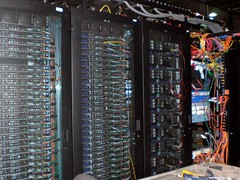 |
| Voice over Internet Protocol, how it works (Photo credit: Wikipedia) |
The previous instalment of this article looked at how the two concepts of VPN and BYOD can be used to improve the work-life balance of employees by providing connected computing and so this second instalment continues the theme with the focus instead on internet based communication channels.
VoIP
VoIP is an acronym which stands for the term Voice over Internet Protocol. In other words, it represents the technologies in which voice data, typically telephone calls, is transferred over the internet. With recent advances in VoIP technology, it is able to almost seamlessly take the place of traditional fixed phone lines and offer many other benefits in addition. As it does replace more and more PSTN (public switched telephone network - the traditional mostly analog network) lines in both our homes and workplaces, often the only way to distinguish whether you are using VoIP vs. PSTN is by the extra functionality that comes with it. Much of this functionality concerns integration, into unified communications packages (see below), and flexibility, both of which allow workers to make more efficient use of their working hours and reduce the work creep into their personal lives.
VoIP packages can vary but the functionality on offer can typically include the ability to make and receive phone calls free of a fixed location or device, as long as an internet connection is available. The user may be able to use differing interfaces to handle calls, depending on the device in question - for example, a web interface and a headset on a desktop computer vs. a mobile phone vs. a digital handset - but the end result will be unaffected as far as the person on the other end of the line is concerned. The consequences for employees is that they are able to work outside of the office (at home for example) to make better use of their time and still be as accessible on the end of the phone as they would normally be on site; often on the same number . Commutes can be negated when needs be and flexible working arrangements can be embraced far more easily.
Video Conferencing
As with VoIP, the benefits of video conferencing, in terms of achieving a better work life balance are all about providing effective but flexible communication possibilities free of location dependencies. The term, sometimes referred to as video chat or video calling, describes scenarios and technologies in which users can talk face to face using video streams over the internet - essentially like VoIP with added video. Many organisations have meeting rooms with video conferencing facilities to allow communication between office locations without the need for travel but the technology is also used in portable devices and desktop computers to provide the means for visual communication on the move. It is possible, for example, to join a meeting in the office using a smartphone when on the train, using video conferencing.
The technology, therefore, allows workers to communicate using all of the visual cues that make face-to-face contact so effective without travelling long distances, or, when more beneficial, from alternative locations such as home. Combined in a unified communications package (see below), it can even facilitate collaboration on work with colleagues as though they were in the same office despite being stationed in disparate locations. All of this reduced travel and location independence does of course mean more time at home as fewer demands on time spilling outside of work hours.
Unified Communications
Bringing all of these together to offer joined up communications channels, is unified communications (UC). This is a very dynamic area of tech but the ultimate goal is that individuals are able to communicate seamlessly, switching between different methods/channels such as voice calls, video calls, email and instant messaging (IM) or SMS, across varying devices and platforms, without the conversation dropping at any stage. UC can use the concept of an integrated inbox where more traditional emails sit alongside IMs and even voicemail messages, managed with unified contact lists. The concept is being adopted at enterprise level with solutions such as Microsoft Lync but it also creeping into our day-to-day lives with developments such as Google Hangouts. The latter brings together our personal conversations across mobile and desktop devices using instant messaging, email and video calling and provides another example of how high technology is permeating our personal lives and in turn increasing the expectation and perceived possibilities of its use in the workplace.
UC is attractive to enterprise because offers businesses efficiencies in terms of the speed and effectiveness of communications alongside reduced travel costs. However, UC adoption in the workplace can also improve both the motivation - due to the effectiveness of the work employees carry out using the technology - and the working hours of employees so that their jobs take less of a toll on their personal lives and ultimately their happiness.
To find out more about the uses of unified communications including VoIP and video conferencing in the workplace you can check out what’s on offer from an enterprise level provider of unified communications.




















